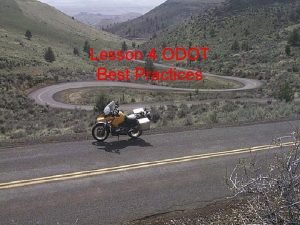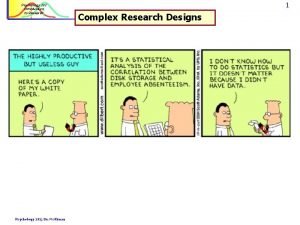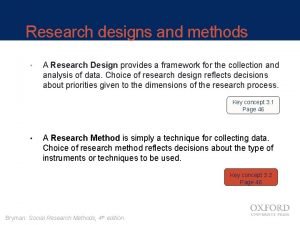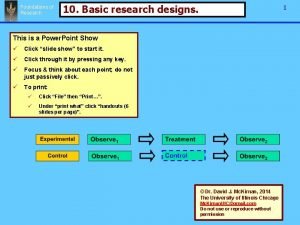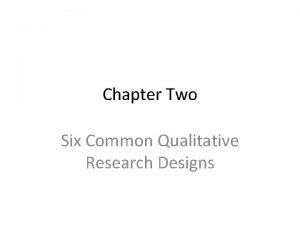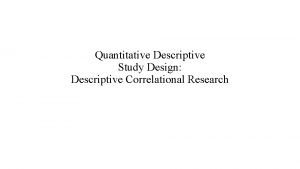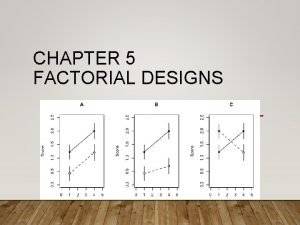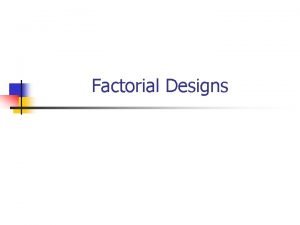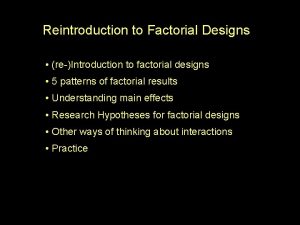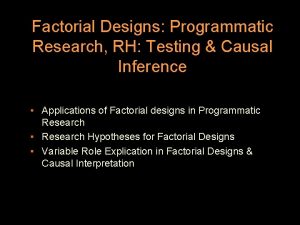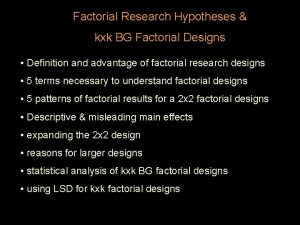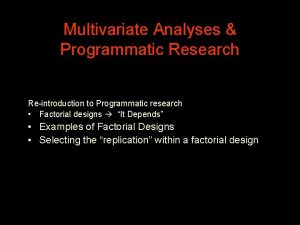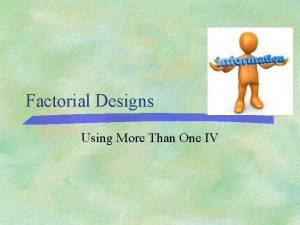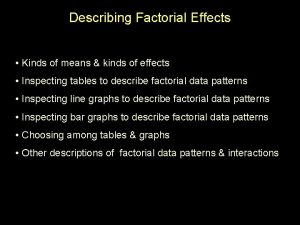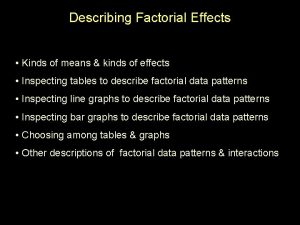Programmatic Research 1 Factorial Designs Kinds of Factorial


























- Slides: 26

Programmatic Research #1: Factorial Designs • • • Kinds of Factorial Designs Causal Interpretability of Factorial Designs Re-introduction to Programmatic research Re-introduction to Multivariate research Factorial designs “It Depends” • The importance of interactions • Application of Factorial Designs in Programmatic research

“Kinds” of 2 -factor Designs BETWEEN GROUPS FACTORIAL DESIGN: • each IV uses a between groups comparison • each participant completes only one condition of the design WITHIN-GROUPS FACTORIAL DESIGN: • each IV uses a within-groups comparison • each participant completes all conditions of the design MIXED FACTORIAL DESIGN: • one IVs uses a between groups comparison and the other IV uses a within-groups comparison. • each participant completes both conditions of the withingroups IV, but completes only one condition of the between groups IV. • it is important to specify which IV is “BG” and which is “WG”

Between groups factorial design experimental or natural grps designs used to study “differences” Each participant is in only one condition, having a particular combination of Initial Diagnosis and Type of Treatment Initial Diagnosis Individual Therapy Group Therapy Depression Clients diagnosed as depressed who are treated with individual therapy Clients diagnosed as depressed who are treated with group therapy Social Anxiety Clients diagnosed with social anxiety who are treated with individual therapy Clients diagnosed with social anxiety who are treated with group therapy

Mixed group factorial design natural groups designs used to study “different changes” or “changing differences” Species was a between groups IV (a turtle can only be a member of one species). Each turtle participated in both the mid-morning & dusk conditions of the Time of Day IV. Species of Turtle Time of Day Snapping Turtle Painted Turtle Mid-morning Each snapping turtle completed a trial during mid-morning Each painted turtle completed a trial during mid-morning Evening Each snapping turtle completed a trial during the evening Each painted turtle completed a trial during the evening

Mixed group factorial design experimental designs used to increase data collection efficiency or statistical power Type of Evidence was a between groups IV -- people can’t read the “same study” twice & give independent ratings. Each participant rated the guilt of both Defendants -- a within-groups IV --as they would in this type of case. Type of Evidence Defendant DNA Eye Witness Major Actor DNA evidence was presented against the major actor An eye witness testified to seeing the major commit the crime Conspirator DNA evidence was presented against the conspirator An eye witness testified to seeing the conspirator commit the crime

Within-groups factorial design – experimental designs used to increase data collection efficiency or statistical power Each participant completed four trials, one of each combination of Retention Interval and Word Type. Retention Interval Word Type Immediate Test Delayed Test Familiar The test was given immediately after the study of a list of 40 familiar words. The test was given 5 minutes after the study of a list of 40 familiar words. Unfamiliar The test was given immediately after the study of a list of 40 unfamiliar words. The test was given 5 minutes after the study of a list of 40 unfamiliar words.

Within-groups factorial design – natural designs to study “changing changes” Each participant was observed in both School & Home (WG) settings both when they were 12 &16 (WG) Age Setting 12 years old 16 years old School Participants were observed in a school setting at age 12. Participants were observed in a school setting at age 16. Home Participants were observed in a home setting at age 12. Participants were observed in a home setting at age 16.

Practice Identifying Types of Factorial Designs - answers next page The purpose of the study was to examine the possible influence of two variables upon maze-learning by rats, length of the maze (either 10 feet or 30 feet) and the size of the reward (either 1 sugar pellet or 5 sugar pellets). Here are three “versions” of the study tell which is BG, WG & MG a. Each rat completed one trial. Each was assigned to either the longer or the shorter maze, and also assigned to receive either 1 or 5 sugar pellets upon completing the maze. b. Each rat completed two trials in either the longer or the shorter maze. Following one trial in the assigned maze, each received 1 pellet reward, after the other trial they received the 5 pellets. c. Each rat completed four trials, two in the shorter maze and two in the longer maze. Each received 1 pellet after one of the short-maze trials and 5 pellets after the other, and also 1 pellet after one of the long-maze trials and 5 pellets after the BG MG WG

Remember about the causal interpretation of effects of a factorial design Start by assessing the causal interpretability of each main effect Remember, in order to causally interpret an interaction, you must be able to casually interpret BOTH main effects. For each of the following: Tell the IVs and tell what effects could be causally interpreted (assuming proper RA, IV manip. and confound control were used): 1. Male and female participants who were African American, Mexican American, or European American were asked to complete a questionnaire about satisfaction with their Senators. zilcho-causo 2. Children played with either a toy gun, a toy car or a puzzle, some while their parents were in the room and some not. The DV was the amount of aggressive behavior they exhibited. 3. Participants played with either a simple puzzle or a complex puzzle in pairs made up of two boys, two girls or one boy & one girl. All three ! Puzzle type only.

Library Research Hypothesis Formation Learning “what is known” about the target behavior Based on Lib. Rsh. , propose some “new knowledge” the “Research Loop” Draw Conclusions Decide how your “new knowledge” changes “what is known” about the target behavior • Novel RH: • Replication • Convergence Does a bivariate finding “hold up” within a multivariate examination ? ? ? Research Design Determine how to obtain the data to test the RH: Data Collection Carrying out the research design and getting the data. Data Analysis Hypothesis Testing Based on design properties and statistical results Data collation and statistical analysis

During the first lecture of this section we talked about the importance of going beyond bivariate research questions and statistical analyses to multivariate questions and analyses. Why multivariate research designs? Multicausality is the idea that behavior is complicated – that any behavior has multiple causes, and so, can be better studied using multivariate research designs with multiple IVs than with bivariate research designs with only a single IV!!! So, multivariate research can be used to …. • involve multiple IVs in a single study to get a more complete picture of the interrelationships among the behaviors we are studying • “check up” on previous results from bivariate research to see if the results we got “hold up” within a multivariate context • is “the effect” we found with the bivariate analysis what we “thought it was”?

Using Factorial Designs in Programmatic Research I Combining 2 Treatments Perhaps the most common application of factorial designs it so look at the separate (main) and combined (interaction) effects of two IVs Often our research starts with a simple RH: that requires only a simple 2 -group BG research design. Computer Lecture Keep in mind that to run this study, we made sure that none of the participants had any other treatments !

Factorial Designs – Separate (Main) and combined (interaction) effects of two treatments At some point we are likely use Factorial designs to ask ourselves about how a 2 nd IV also relates to the DV Gets Indiv & Hw Gets Group & Hw Indiv Group Homework Exam Prep Gets Indiv & Prep Gets roup& Prep

Remember the Brownies? We wanted to look at the individual and combined effects of 2 ingredients!! That required a factorial design.

Using Factorial Designs in Programmatic Research II “Correcting” Bivariate Studies Our well sampled, carefully measured, properly analyzed study showed … ~Fback 40 40 … nothing ! Our well sampled, carefully measured, properly analyzed study showed … Familial 40 … nothing ! Looks like neither IV is related to the DV !!! Unfamiliar 40

~Fback However, when we analyzed the same data including both variables as IVs … Familiar Unfamiliar 60 20 40 20 60 40 40 40 There are Feedback effects both for Familiar & Unfamiliar – the marginal means are an “aggregation error” There are Familiarity effects both Fback & ~Fback – the marginal means are an “aggregation error” So, instead of the “neither variable matters” bivariate results, the multivariate result shows that both variables related to the DV t -- they interact !!!!!

When to ask, “Is that conditional or unconditional”? ? ? #1 Treatment effects We are constantly being told that some treatment “works” or “works better”… We must immediately ask, “Always? Really? What about for different…? ? “ “Diet A is better than Diet B for people who work out!” “people who work out” is not a homogeneous group – there are many kinds of “work out” !!

When to ask, “Is that conditional or unconditional”? ? ? #2 Differences between “kinds” of people We are constantly being told that some groups “have it better” than other groups … We must immediately ask, “Always? Really? What about for different…? ? “ “Group 1 gets paid more than Group 2!” there are many kinds of “jobs” !! … and the “story” is very different for different jobs!

Using Factorial Designs in Programmatic Research III Between Groups Factorial Designs: Generalizability across Populations, Settings & Tasks Often our research starts with a simple RH: that requires only a simple 2 -group BG research design. Computer Lecture Keep in mind that to run this study, we had to make some choices/selections: For example: population College Students setting Lecture setting stim/task teach Psychology

Using Factorial Designs in Programmatic Research III When we’ve found and replicated an effect, making certain selections, it is important to check whether changing those selections changes the results. Computer 60 Lecture 40 If there is no interaction – if the results “don’t depend upon” the population, task/stimulus, setting, etc – we need to know that, so we can apply the results of the study to our theory or practice, confident in their generalizability If there is an interaction – if the results “depend upon” the population, task/stimulus, setting, etc – we need to know that, so we can apply the “correct version” of the study to our theory or practice

Between Groups Factorial Designs – Do effects “depend upon” Populations, Settings or Tasks ? At some point we are likely use BG Factorial designs to ask ourselves how well the results will generalize to: • other populations – college vs. high school • other settings – lecture vs. laboratory Tx Control Col HS • other tasks/stimuli – psyc vs. philosophy Tx Psyc Phil Control Lecture On-line

Tx Psyc Phil 60 Notice that each factorial design includes a replication of the earlier design, which used the TX instructional methods to : • teach Psychology Tx Control • to College Students • in a Lecture setting Control 40 60 ? ? 40 ? ? Tx Control Col 60 40 HS ? ? Tx Each factorial design also provides a test of the generalizability of the original findings: • w/ Philosophy vs. Psychology • to High School vs. College Students • in an On-line vs. Lecture setting Control Lecture 60 40 On-line ? ?

Using Factorial Designs in Programmatic Research IV Mixed Groups Factorial Designs: Time-course research As before, often our research starts with a simple RH: that requires only a simple 2 -group BG research design. Tx 1 20 Tx 2 40 Time Course Investigations In order to run this study we had to select ONE treatment duration (say 16 weeks): • we assign participants to each condition • begin treatment of the Tx groups • treat for 16 weeks and then measured the DV

Mixed Groups Factorial Designs for Time Course Investigations Tx 1 Tx 2 Using this simple BG design we can “not notice” some important things. A 20 40 MG Factorial can help explore the time course of the Tx effects. 16 wks By using a MG design, with different lengths of Tx as the 2 nd IV, we might find different patterns of data that we would give very different interpretations 16 wks Tx 1 20 32 wks 40 16 wks Tx 1 20 Tx 1 40 40 x 2 40 20 20 40 40 T x 2 16 wks 32 wks 60 Tx 1 T Tx 2 32 wks 40 T x 2 32 wks 20 0 40 60

Using Factorial Designs in Programmatic Research V Mixed Groups Factorial Designs: Evaluating initial equivalence if RA is not possible As before, often our research starts with a simple RH: that requires only a simple 2 -group BG research design. Tx 1 Tx 2 Initial Equivalence Investigations In order to causally interpret the results of this study, we’d have to have initial equivalence • but we can’t always RA & manipulate the IV • So what can we do to help interpret the post-treatment differences of the two treatments? • Answer – compare the groups before treatment too!

Mixed Groups Factorial Designs to evaluate Initial Equivalence By using a MG design, we can compare the groups pre-treatment and use that information to better evaluate post-treatment group differences (but can’t really infer cause). For which of these would you be more comfortable conclusing that Tx 1> Tx 2 ? ? Pre Tx 1 60 Post 40 T x 2 20 20 Nah – Tx 1 lowered score Tx 1 x 2 40 40 20 20 Nah – Post dif = pre dif ! Pre Post 30 60 20 Post T T x 2 Pre 40 Tx 1 Pre Post 20 40 20 20 T x 2 As good as it gets! Maybe – more increase by Tx 1
 Programmatic research
Programmatic research Mixed factorial design
Mixed factorial design The constellation
The constellation Programmatic risk examples
Programmatic risk examples Programmatic music
Programmatic music Odot programmatic
Odot programmatic Factorial research design in psychology
Factorial research design in psychology Findings of qualitative research
Findings of qualitative research Types of study design
Types of study design Basic research designs
Basic research designs Chapter 10 qualitative research designs
Chapter 10 qualitative research designs Types of qualitative design in research
Types of qualitative design in research Types of action research design
Types of action research design Empirical approach
Empirical approach Types of quantitative research designs
Types of quantitative research designs Descriptive correlational quantitative research design
Descriptive correlational quantitative research design Research design
Research design Discuss descriptive and casual research designs
Discuss descriptive and casual research designs Example of causal research
Example of causal research Conclusive research definition
Conclusive research definition Experimental vs non experimental
Experimental vs non experimental The characteristic of qualitative research
The characteristic of qualitative research Research design for exploratory research
Research design for exploratory research Research designs
Research designs Exploratory research vs conclusive research
Exploratory research vs conclusive research Quasi-experimental research designs
Quasi-experimental research designs Quasi-experimental research designs
Quasi-experimental research designs





